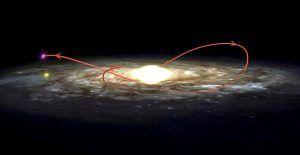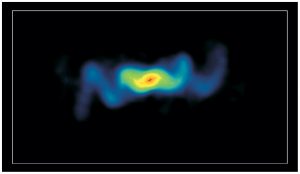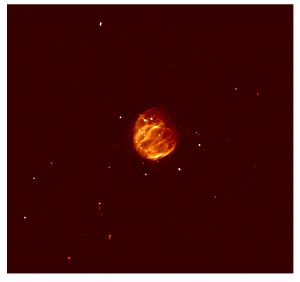Orbital path (red line) of black hole XTE J1118+480 and its companion through the Milky Way Galaxy over the past 230 million years. Yellow circle indicates the Sun’s current position.


A Wobbling Jet
Inside the famous Manatee Nebula (W50) lies the black hole remnant of the supernova that formed it, called SS 433. Its jets wobble as they force charged particles outward. Over time, this creates a swirling tracer pattern to the radio waves picked up by the Very Large Array (VLA).

Glowing Bubble of an Exploded Star
Radio image of supernova remnant G55.7+3.4 shows previously-unseen filamentary structure, thanks to enhancements made to the Very Large Array (VLA).

Across the Milky Way (blue version)
A radio and infrared wave panorama of a section of the Milky Way in the constellations of Scutum and Aquila. Normal stars show up as the myriad of blue-white points. Radiation from the newborn stars heats surrounding dust into infrared temperatures (in blue), while the ultraviolet light from these stars separates electrons from hydrogen atoms, and gives off radio waves (in red). More mature stars have destroyed nearby dust, leaving red cores surrounded by pink, then blue, shells as the temperature drops far from the stars. Massive stars have died in titanic explosions and blasted their gas light years into space at thousands of miles per second, leaving blast arcs (in red). The diffuse infrared glow (blue) comes from the tiny dust particles scattered through space.

Across the Milky Way (teal version)
A radio and infrared wave panorama of a section of the Milky Way in the constellations of Scutum and Aquila. Normal stars show up as the myriad of aqua-white points. Radiation from the newborn stars heats surrounding dust into infrared temperatures (in teal), while the ultraviolet light from these stars separates electrons from hydrogen atoms, and gives off radio waves (in red). More mature stars have destroyed nearby dust, leaving red cores surrounded by pink, then teal, shells as the temperature drops far from the stars. Massive stars have died in titanic explosions and blasted their gas light years into space at thousands of miles per second, leaving blast arcs (in red). The diffuse infrared glow (teal) comes from the tiny dust particles scattered through space.

Across the Milky Way (violet version)
A radio and infrared wave panorama of a section of the Milky Way in the constellations of Scutum and Aquila. Normal stars show up as the myriad of aqua-white points. Radiation from the newborn stars heats surrounding dust into infrared temperatures (in violet), while the ultraviolet light from these stars separates electrons from hydrogen atoms, and gives off radio waves (in red). More mature stars have destroyed nearby dust, leaving red cores surrounded by aqua, then violet, shells as the temperature drops far from the stars. Massive stars have died in titanic explosions and blasted their gas light years into space at thousands of miles per second, leaving blast arcs (in red). The diffuse infrared glow (violet) comes from the tiny dust particles scattered through space.





